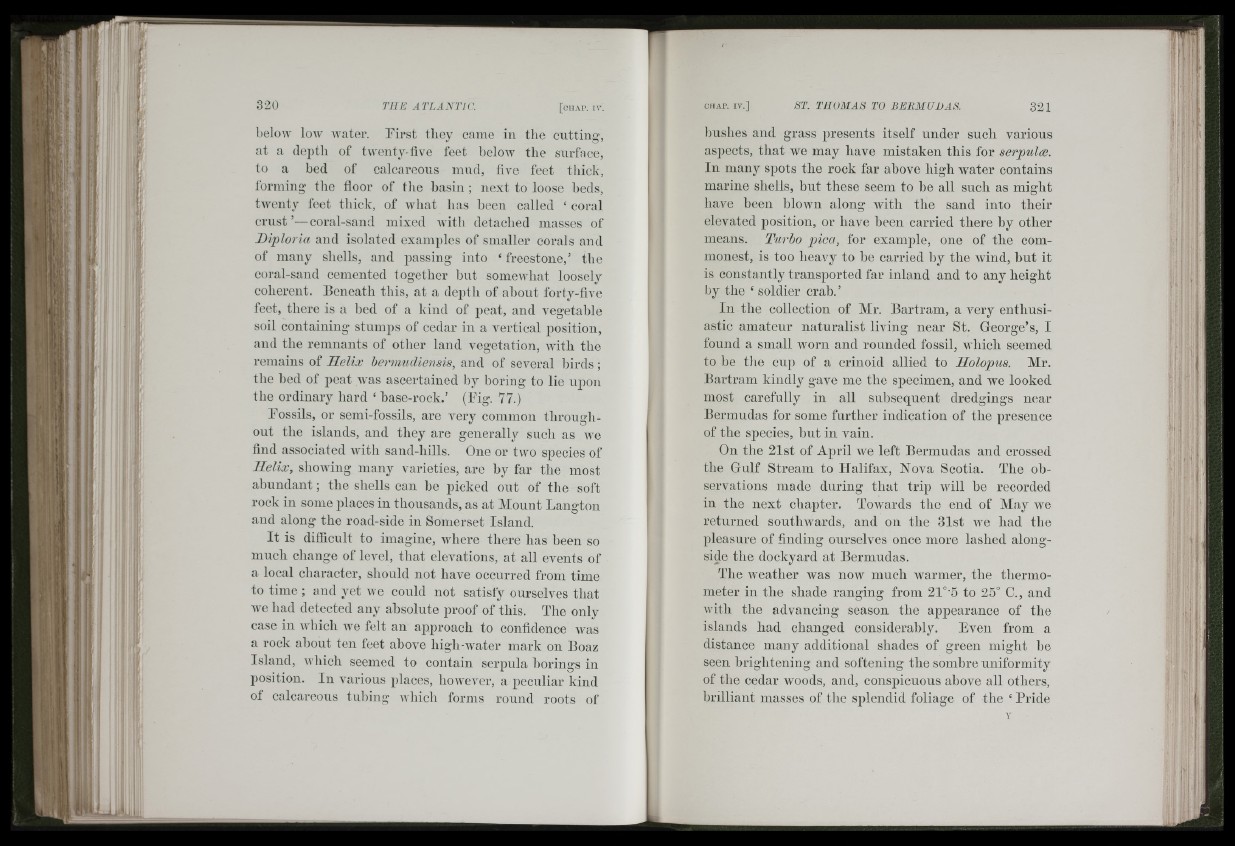
I;: J
;iRt)":
n
.
t »I-
'/ m
I- '4
m!«■
il'A
. !i
n
t il
; ir
IfM ;•
i 1C
3 2 0 THE ATLANTIC.
beloAv low water. Tirst they came in the cutting,
at a depth of twenty-five feet below the surface,
to a bed of calcareous mud, five feet thick,
forming tlie floor of flic basin ; next to loose beds,
tAventy feet thick, of what has heen called ‘ coral
crust’—coral-sand mixed Avitli detached masses of
Diploria and isolated examples of smaller corals and
of many shells, and passing into ‘ freestone,’ the
coral-sand cemented together hut somewhat loosely
coherent. Beneath this, at a depth of ahout forty-tive
feet, there is a bed of a kind of peat, and vegetable
soil containing stumps of cedar in a vertical position,
and the remnants of other land vegetation, AA'ith the
remains of Helix hermudiensis, and of several birds ;
the bed of peat Avas ascertained by boring to lie upon
the ordinary hard ‘ hase-rock.’ (Eig. 77.)
Eossils, or semi-fossils, are very common throughout
the islands, and they are generally such as we
find associated Avith sand-hills. One or two species of
Helix, shoAving many varieties, are hy far the most
abundant; the shells can be picked ont of tlie soft
rock in some places in thousands, as at Mount Langton
and along the road-side in Somerset Island.
It is difficult to imagine, Avhere there has heen so
much change of level, tliat elevations, at all events of
a local character, should not have occurred from time
to time ; and yet we could not satisfy ourselves that
Ave had detected any absolute proof of this. The only
case in Avhich Ave felt an approach to confidence was
a rock about ten feet ahove high-Avater mark on Boaz
Island, Avhich seemed to contain serpula borings in
position. In various places, hoAA'ever, a peculiar kind
ot calcareous tubing A\hich forms round roots of
hushes and grass presents itself under such various
aspects, that we may have mistaken this for serpulce.
In many spots the rock far above high water contains
marine shells, but these seem to be all such as might
have been blown along Avith the sand into their
elevated position, or have been carried there by other
means. Turbo pica, for example, one of the commonest,
is too heavy to he carried by the Avind, but it
is constantly transported far inland and to any height
by the ‘ soldier crab. ’
In the collection of Mr. Bartram, a very enthusiastic
amateur naturalist living near St. George’s, I
found a small AVorn and rounded fossil, which seemed
to be the cup of a crinoid allied to Holopus. Mr.
Bartram kindly gave me the specimen, and Ave looked
most carefully in all subsequent dredgings near
Bermudas for some further indication of the presence
of the species, but in vain.
On the 21st of April Ave left Bermudas and crossed
the Gulf Stream to Halifax, Nova Scotia. The ohservations
made during that trip Avill he recorded
in the next chapter. Towards the end of Alay we
returned southwards, and on the 31st Ave had the
pleasure of finding ourselves once more lashed alongside
the dockyard at Bermudas.
The Aveather was now much Avarmer, the thermometer
in the shade ranging from 21°'5 to 25° C., and
AA'ith the advancing season the appearance of the
islands had changed considerably. Even from a
distance many additional shades of green might he
seen brightening and softening the sombre uniformity
of the cedar woods, and, conspicuous ahove all others,
brilliant masses of the splendid foliage of the ‘ Pride
I A
i
l?lig
ilii,. I
ill ;:a . i li
... te